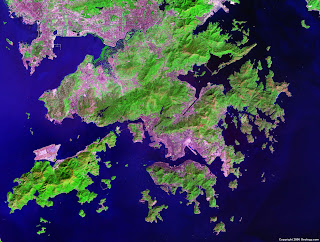>Site and Situation
Two concepts used to describe and understand the geography nature of cities are “site” and “situation.”
A city’s site is the actual location of a city in terms of its physical characteristics—landforms such as mountains or bays, fresh water supplies, or soil quality for example. New York City is an example of a city whose site included a natural harbor with an unusually long sheltered coastline due to the arrangement of the physical features of the area. Many cities along the eastern part of the United States are located along the physical feature called the Fall Line, where the foothills of the Appalachians reach the coastal plain. This feature provided the opportunity for the development of early water power.
The concept of “situation” is much more fluid. A city’s situation is defined as the location of a place relative to its surroundings and other places—its location relative to elsewhere. Situational features might include accessibility to major transportation routes and resources. New York City grew in importance partially due to its location and accessibility relative to the Hudson River Valley and the Erie Canal, early major commercial routes that gave access to rich agricultural lands. Likewise, the poor site of New Orleans is overshadowed by its unique situation—the place where ocean ships meet river barges bringing the rich resources of the agricultural heartland of the U.S. to the world. Situational characteristics that affect places are extremely changeable.
Before I came to Hong Kong, it was a “site” in the most minimalist terms in my mind. It was an island and mainland area along the coast with a subtropical climate and I think I knew that it was mountainous, but now I’m not even sure how clear I was on that. If the site was pretty vague in my mind, the situation was perhaps even more so. I knew it had been part of the British colonial empire and returned to China in 1997, so in some ways, its relationship to the UK was stronger in my mental image of its situation than its relationship with China.
So what have I learned about the site of Hong Kong? Hong Kong is built on volcanic and granitic rock—85% of the total land area—that form mountains and hills with steep slopes. It actually includes a group of islands, including Hong Kong Island, along with a land area on the mainland. The highest peaks are almost 1000 meters (3000 feet). What is significant about this? The arrangements of the islands and mainland, much like New York City, provided for an extra long coastal area that allowed for the development of port terminals. This was Hong Kong’s great advantage over Macau. While the mountains have restricted some development, the hard bedrock certainly allow for the building on skyscrapers. And water has always been a challenge in Hong Kong. Imagine about 7000 people living in this rugged landscape when the British arrived and now there are seven million people. But there are few natural lakes or rivers, and no substantial groundwater—granite is not a great aquifer rock body. This is why there are many country parks in the mountains. These are the areas where dams were build to create reservoirs to provide water for the growing population.
And its situation? Imagine the situation up until 1997—growing population, limited fresh water, and a hostile country next door. Many of the water projects related to this context. In one area they even closed off the ocean, pumped out the sea water, and let fresh water accumulate. Today most of the water comes from the Dongiiang River in China and seawater is used for toilet flushing to limit demand for freshwater. The reservoirs are in a sense a backup in case they get backed against the wall. But this change in source of water represents both a real and metaphorical change in situation for Hong Kong.
Before 1997, Hong Kong was a significant outpost of a major western power—Great Britain was at their back. Now imagine the change. Hong Kong is now a Special Administrative Region of the Peoples Republic of China. Hong Kong has 7 million people. The PRC has more than 1 billion people with cities like Guangzhou, Shanghai, Beijing, etc. And the economic power of the PRC in enormous. Imagine what would happen if all the universities in Hong Kong had to accept students from the PRC on a competitive basis with local students? Imagine trying to negotiate your way toward a more representative form of government with Beijing? What is to keep all the major financial institution in Hong Kong, now that China is open for business? Many of the eduational changes taking place in Hong Kong are driven by a concern that the Hong Kong SAR will become a backwater, a minor player in the Chinese context. The “situation” has been changed by the decisions of two of the world’s major players and Hong Kong is left trying to sort out the results. Hong Kong's water source has changed.

